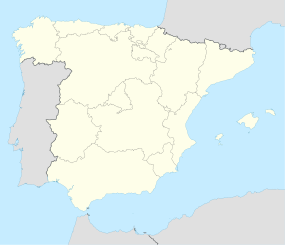Tarraco

|
|
| Location | Tarragona, Catalonia, Spain |
|---|---|
| Region | Hispania |
| Coordinates | 41°6′59″N 1°15′19″E / 41.11639°N 1.25528°ECoordinates: 41°6′59″N 1°15′19″E / 41.11639°N 1.25528°E |
| Type | Settlement |
| History | |
| Cultures | Iberian, Roman |
| Official name | Archaeological Ensemble of Tárraco |
| Type | Cultural |
| Criteria | ii, iii |
| Designated | 2000 (24th session) |
| Reference no. | 875rev |
| Region | Europe and North America |
Tarraco is the ancient name of the current city of Tarragona (Catalonia, Spain). It was the oldest Roman settlement on the Iberian Peninsula, founded during the Second Punic War by Scipio Calvus, and became capital of the Roman province of Hispania Citerior, and of Hispania Tarraconensis during the Roman Empire.
In 2000, the archaeological ensemble of Tarraco was declared a World heritage site by UNESCO.
The municipality was inhabited in pre-Roman times by Iberians who had commercial contacts with the Greeks and Phoenicians who settled on the coast. The Iberian colonies were mainly located in the Ebro Valley. Evidence of Iberian colonies in the municipality of Tarragona has been dated to the 5th century BC.
References in the literature to the presence of Iberians in Tarraco are ambiguous. Livy mentions an oppidum parvum (small town) called Cissis and Polybius talks about a polis called Kissa (Κίσσα). Tarraco is mentioned for first time shortly after the arrival of Gnaeus Cornelius Scipio Calvus at Empúries in 218 BC at the start of the Second Punic War which began the Roman conquest of Hispania. Livy writes that the Romans conquered a field of Punic supplies for Hannibal's troops near Cissis and took the city. A short time later, the Romans were attacked "not far from Tarraco" (haud procul Tarracone). But it remains unclear whether Cissis and Tarraco were the same city. A coin found in Empúries bears the inscription Tarakon-salir (salir probably means silver). The coin, engraved in keeping with other Empúries models at an undisclosed location, is generally dated to 250 BC, certainly before the arrival of the Romans. The name Kesse appears on coins of Iberian origin from the 1st and 2nd century BC that were marked according to Roman weight standards. Kesse may be equated with Cissis, the place of origin of the Cissisians mentioned by Pliny.
...
Wikipedia

